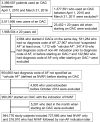Effectiveness and Safety of Reduced and Standard Daily Doses of Direct Oral Anticoagulants in Patients with Nonvalvular Atrial Fibrillation: A Cohort Study Using National Database Representing the Japanese Population
- PMID: 35520279
- PMCID: PMC9064485
- DOI: 10.2147/CLEP.S358277
Effectiveness and Safety of Reduced and Standard Daily Doses of Direct Oral Anticoagulants in Patients with Nonvalvular Atrial Fibrillation: A Cohort Study Using National Database Representing the Japanese Population
Abstract
Purpose: To compare the effectiveness and safety of reduced or standard daily doses of direct oral anticoagulants (DOACs) with warfarin in Japanese patients with nonvalvular atrial fibrillation (NVAF). We used post-hoc analyses to identify patient groups that could benefit from reduced-dose DOACs.
Patients and methods: Using the National Database of Health Insurance Claims and Specific Health Checkups of Japan, we identified 944,776 patients with NVAF who had started an oral anticoagulant after at least one year of non-use between April 2011 and March 2016. We matched patients taking any, reduced, or standard doses of DOACs 1:1 with those taking warfarin. We measured treatment effectiveness based on admission due to stroke or systemic embolism (S/SE) and safety based on admission due to any bleeding (defined as major bleeding, MB). We compared both outcomes between DOACs and warfarin using the Cox proportional hazards model. We used post-hoc analysis to match patients receiving reduced-dose DOACs to those receiving standard-dose DOACs and compared treatment effectiveness and safety.
Results: More than half of patients receiving DOACs used a reduced dose. The occurrences of S/SE and MB in patients receiving any, reduced, or standard doses of DOACs were equal to or lower than those receiving warfarin. In the post-hoc analysis, the risk of S/SE and MB was similar between reduced and standard doses of DOACs except for those with a history of cerebral infarction and CHA2DS2-VASc score ≥3, where the risk of S/SE was lower for reduced doses of any and individual DOACs.
Conclusion: Findings from the current study are consistent with recent Asian and global studies but different from most studies conducted in North America and Europe, where patients receiving a reduced dose of DOACs had an increased risk of S/SE. Future studies should test the reproducibility of results from the current study.
Keywords: CHA2DS2-VASc score; atrial fibrillation; database; oral anticoagulant; pharmacoepidemiology; propensity score.
© 2022 Kubota and Ooba.
Conflict of interest statement
The authors report no conflicts of interest in this work.
Figures



Similar articles
-
Effectiveness and Safety of Direct Oral Anticoagulants in an Asian Population with Atrial Fibrillation Undergoing Dialysis: A Population-Based Cohort Study and Meta-Analysis.Cardiovasc Drugs Ther. 2021 Oct;35(5):975-986. doi: 10.1007/s10557-020-07108-4. Epub 2020 Nov 19. Cardiovasc Drugs Ther. 2021. PMID: 33211254
-
Effectiveness and Safety of Four Direct Oral Anticoagulants in Asian Patients With Nonvalvular Atrial Fibrillation.Chest. 2019 Sep;156(3):529-543. doi: 10.1016/j.chest.2019.04.108. Epub 2019 May 16. Chest. 2019. PMID: 31103697
-
Real-World Comparative Effectiveness, Safety, and Health Care Costs of Oral Anticoagulants in Nonvalvular Atrial Fibrillation Patients in the U.S. Department of Defense Population.J Manag Care Spec Pharm. 2018 Nov;24(11):1116-1127. doi: 10.18553/jmcp.2018.17488. Epub 2018 Sep 13. J Manag Care Spec Pharm. 2018. PMID: 30212268 Free PMC article.
-
Periprocedural Outcomes of Direct Oral Anticoagulants Versus Warfarin in Nonvalvular Atrial Fibrillation.Circulation. 2018 Oct 2;138(14):1402-1411. doi: 10.1161/CIRCULATIONAHA.117.031457. Circulation. 2018. PMID: 29794081
-
Direct Oral Anticoagulants vs. Warfarin in Latin American Patients With Atrial Fibrillation: Evidence From Four post-hoc Analyses of Randomized Clinical Trials.Front Cardiovasc Med. 2022 Mar 4;9:841341. doi: 10.3389/fcvm.2022.841341. eCollection 2022. Front Cardiovasc Med. 2022. PMID: 35310968 Free PMC article.
Cited by
-
Trend of anticoagulant therapy in elderly patients with atrial fibrillation considering risks of cerebral infarction and bleeding.Sci Rep. 2023 Jan 5;13(1):192. doi: 10.1038/s41598-022-26741-7. Sci Rep. 2023. PMID: 36604482 Free PMC article.
-
Literature Review of Studies Using the National Database of the Health Insurance Claims of Japan (NDB): Limitations and Strategies in Using the NDB for Research.JMA J. 2024 Jan 15;7(1):10-20. doi: 10.31662/jmaj.2023-0078. Epub 2023 Dec 27. JMA J. 2024. PMID: 38314426 Free PMC article. Review.
-
Stroke Research Using Administrative Claims Database in Japan: A Narrative Review.J Atheroscler Thromb. 2024 Oct 1;31(10):1341-1352. doi: 10.5551/jat.RV22022. Epub 2024 Aug 3. J Atheroscler Thromb. 2024. PMID: 39098041 Free PMC article. Review.
-
Association between statin use and cataract formation in a retrospective cohort study using Japanese health screening and claims data.Sci Rep. 2025 Apr 19;15(1):13594. doi: 10.1038/s41598-025-97889-1. Sci Rep. 2025. PMID: 40253569 Free PMC article.
-
Effectiveness and safety of non-vitamin K antagonist oral anticoagulants in low-weight patients with atrial fibrillation.J Thromb Thrombolysis. 2024 Oct;57(7):1268-1280. doi: 10.1007/s11239-024-03016-8. Epub 2024 Aug 14. J Thromb Thrombolysis. 2024. PMID: 39143401 Free PMC article.
References
-
- January CT, Wann LS, Calkins H, et al. 2019 AHA/ACC/HRS focused update of the 2014 AHA/ACC/HRS guideline for the management of patients with atrial fibrillation: a report of the American College of Cardiology/American Heart Association Task Force on clinical practice guidelines and the heart rhythm society. Circulation. 2019;140:e125–e151. doi:10.1161/CIR.0000000000000665 - DOI - PubMed
-
- Hindricks G, Potpara T, Dagres N, et al. 2020 ESC guidelines for the diagnosis and management of atrial fibrillation developed in collaboration with the European Association for Cardio-Thoracic Surgery (EACTS): the Task Force for the diagnosis and management of atrial fibrillation of the European Society of Cardiology (ESC) developed with the special contribution of the European Heart Rhythm Association (EHRA) of the ESC. Eur Heart J. 2021;42(5):373–498. doi:10.1093/eurheartj/ehaa612 - DOI - PubMed
-
- Ono K, Iwasaki Y, Shimizu W, et al. JCS/JHRS 2020 guideline on pharmacotherapy of cardiac arrhythmias. Available from: https://www.j-circ.or.jp/cms/wp-content/uploads/2020/01/JCS2020_Ono.pdf. Accessed January 2, 2022. - PubMed
LinkOut - more resources
Full Text Sources
Miscellaneous

